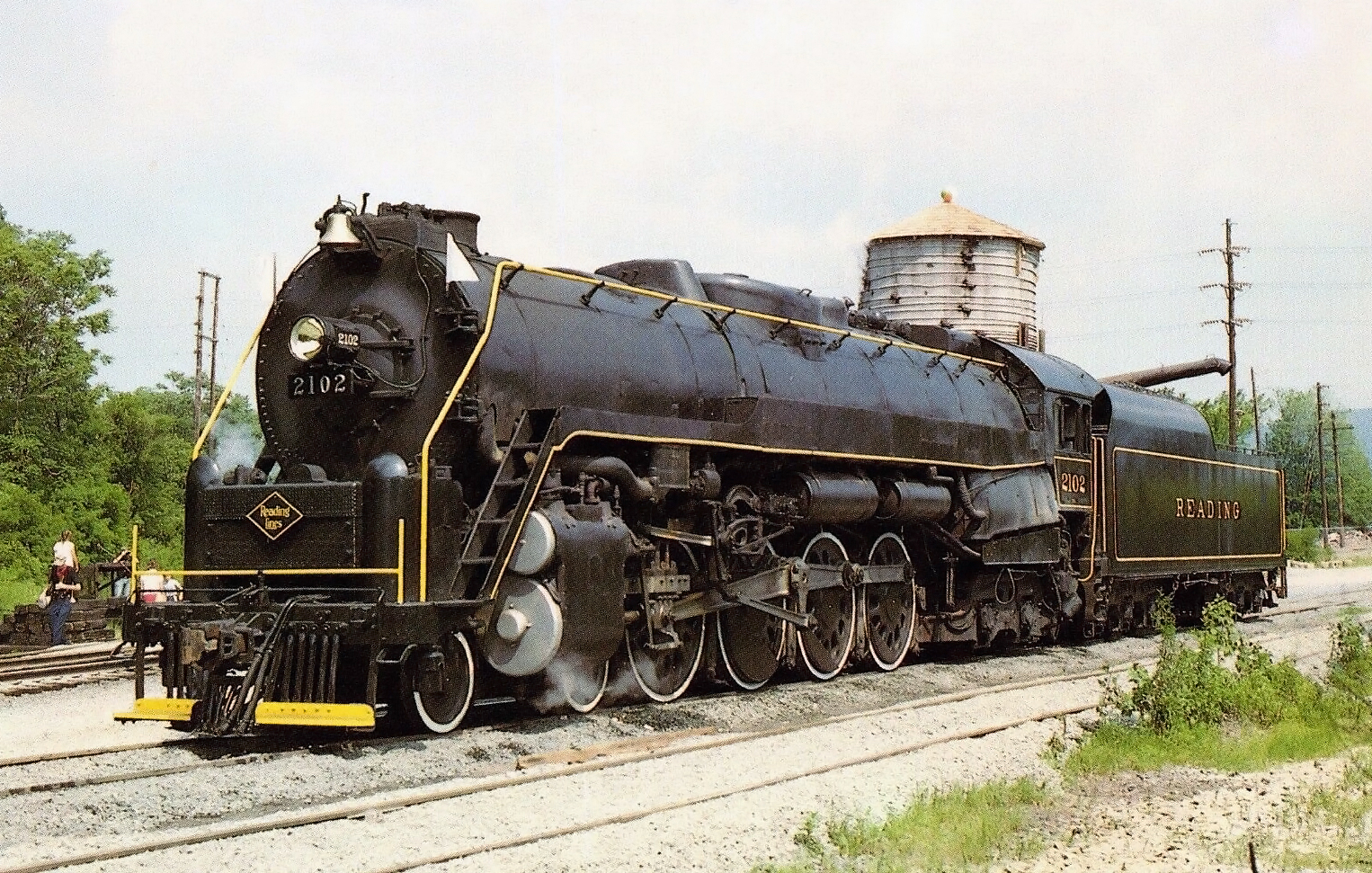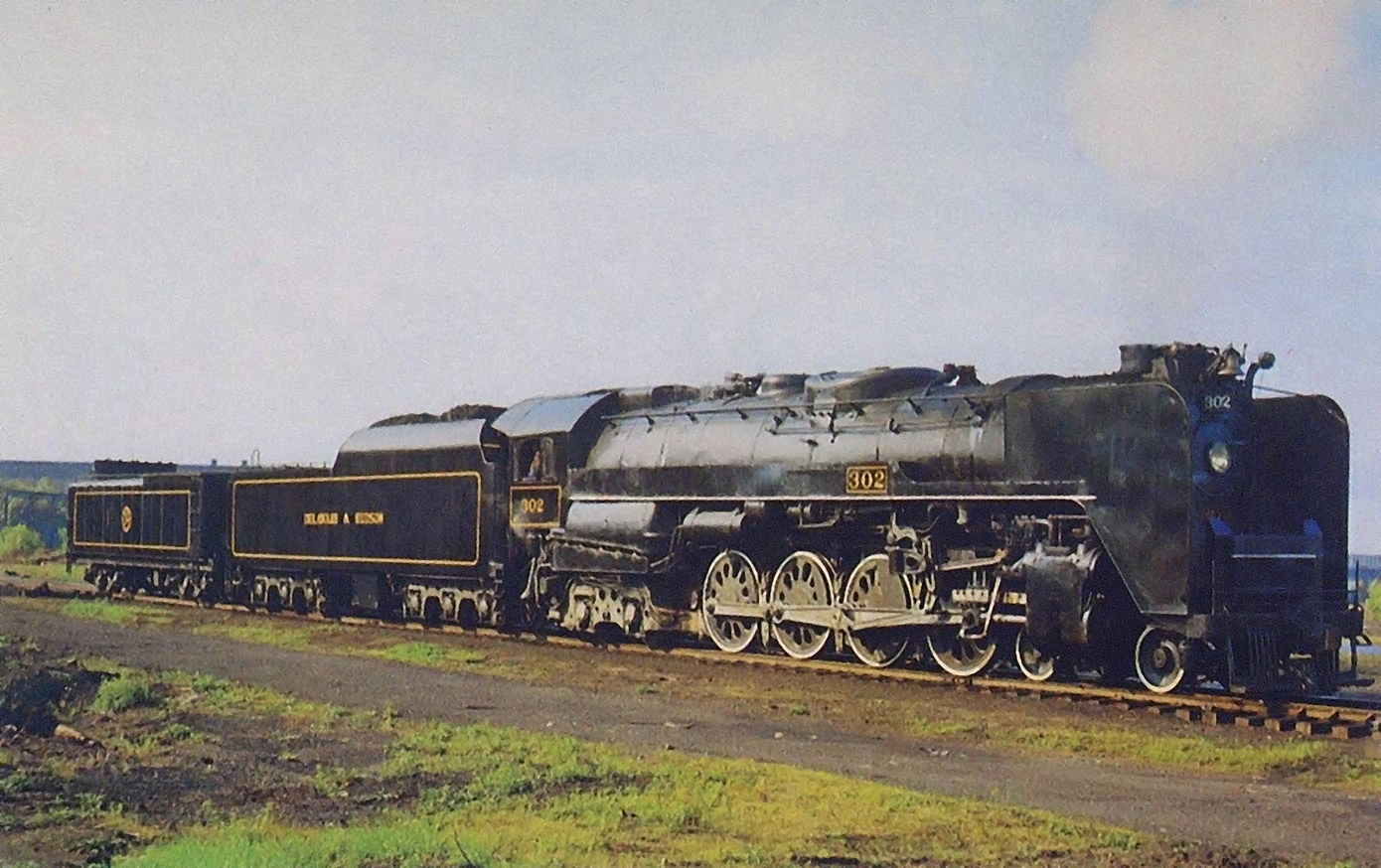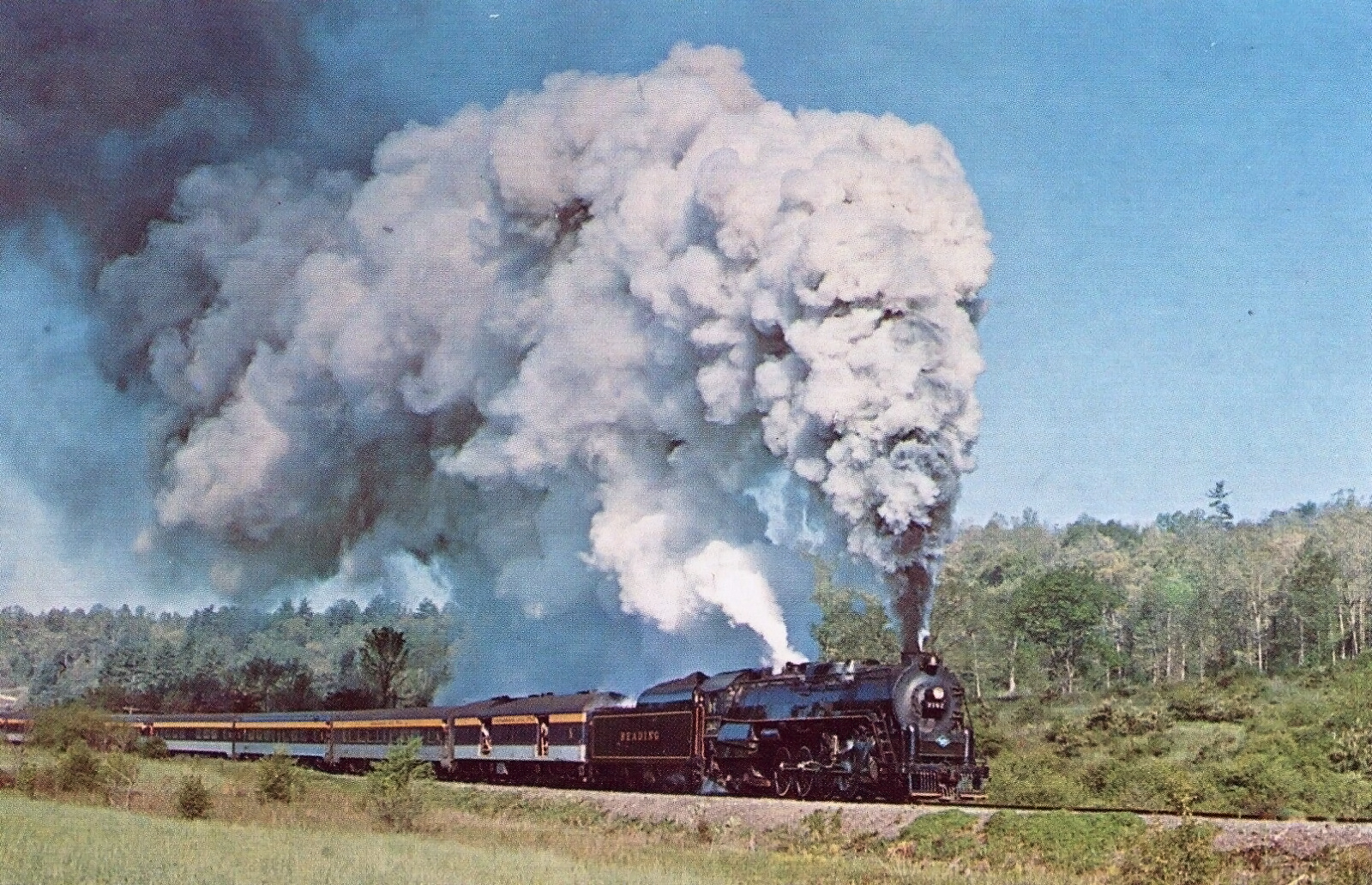Reading 4-8-4 2102: Specs, History, Photos
Last revised: August 25, 2024
By: Adam Burns
Reading 2102 is a 4-8-4 type steam locomotive that predominantly moved anthracite coal over the Reading system until its 1957 retirement.
The engine became famous for leading the company's popular "Iron Horse Rambles" during the early 1960s, and continued occasionally pulling special fan trips during the 1970s, 1980s, and early 1990s.
2102 was built by Reading's own shop forces in 1945 from 2-8-0 Consolidations and part of its well-known "T-1" class. Today, the locomotive is one of three Reading 2100s that have been preserved, which also includes 2101 and 2124.
Beginning in 2016 the Reading, Blue Mountain & Northern, a successful regional freight line in Pennsylvania, began restoration efforts on 2102 for its own popular excursion program.
Following six years of overhaul, which took place at the company's shops in Port Clinton, Pennsylvania, the big Northern was returned to active service in April, 2022.
Photos
 This photo by Carl Sturner features Reading 2102 being serviced on the Blue Mountain & Reading at South Hamburg, Pennsylvania while leading excursions on Railfan Weekend on June 29, 1986.
This photo by Carl Sturner features Reading 2102 being serviced on the Blue Mountain & Reading at South Hamburg, Pennsylvania while leading excursions on Railfan Weekend on June 29, 1986.Operational History
By the late 1920s, the Reading maintained a vast fleet of 1,015 2-8-0 Consolidations. Like most railroad, the anthracite road used these engines in all types of applications, from heavy freight service to light branch line work.
With the advent of "Super Power" steam technology and the need for more powerful locomotives to handle wartime traffic demands, Reading president Revelle W. Brown requested superintendent of motive power and rolling equipment, E. Paul Gangewere to consult with Baldwin regarding converting 30 I-10a Consolidations into 4-8-4s.
The project was carried out at the Reading's own shops in Reading, Pennsylvania and utilized 2-8-0s #2020-2049 rebuilt as 4-8-4s #2100-2129. The project was a combination of reused components and new parts from Baldwin and other vendors.
The first twenty were designated solely for freight service, predominantely to handle anthracite coal while the last ten were intended to be used in passenger service. However, aside from handling a few troop trains these engines were also employed in freight duties.
The locomotives were completed between 1945-1947 and proved fine machines. Their operational performance validated the company's decision time and again to carry out the rebuild program. 2102 became a crucial part of the daily freight handling operations.
Ironically, the locomotive had witnessed barely a decade of operational service before the Reading retired it, along with most of its remaining steam fleet, in 1957 for newly arriving diesels.
Iron Horse Rambles
Following its retirement, 2102 was sold to the Carpenter Steel Corporation as a static steam generator for plant use. In an ironic twist of fate, the engine was badly damaged in a plant fire in the fall of 1960.
The Reading, having already enjoyed a great of success with its "Iron Horse Rambles" since 1959 behind sister locomotive 2100, repurchased 2102 in 1960 for these popular excursions.
Following an extensive rebuild the T-1 led the first "Ramble" between Wayne Junction (Philadelphia) and Shamokin, Pennsylvania on April 29, 1962.
Between the years 1962 and 1964, 2102 carved a special place for itself in railroad history leading the "Reading Rambles," and in the process became a beloved symbol of scenic journeys and nostalgia for many rail enthusiasts. These excursions further solidified the locomotive’s reputation for robust performance and reliability.
Other Notable Excursions
After the Rambles ended in 1964, 2102 was sold to Steam Tours, Inc., based out of Akron, Ohio on January 31, 1965. This transaction marked the beginning of a new chapter in the 2102's storied history as it continued on its journey of service in different capacities.
During the subsequent decades of the 60s, 70s, and 80s, 2102 led numerous other excursions, continuing to enthrall rail enthusiasts across the nation. Its consistent performance added adventurous allure to these journeys, with its chugging rhythm becoming a symphony of human engineering to its admirers.
Some of 2102's more renowned excursions after the Rambles included heading up excursions on the short-lived "Greenbrier Scenic Railroad" which operated over the Chesapeake & Ohio's now-abandoned Greenbrier Division between from Ronceverte and Cass, West Virginia in the spring and fall of 1971.
At the time the 4-8-4 was the largest steam locomotive in operation worldwide. Passengers who so wished could also catch the Cass Scenic Railroad at Cass and ride as far as Whittaker Station.
A year later, in 1972, it led excursions on Ross Rowland's High Iron Company, which sponsored several excursions between Reading and Harrisburg. In 1973, it was renumbered and redressed as "Delaware & Hudson #302" (K-62) to celebrate that railroad's 150th anniversary.
In 1983, 2102 was acquired by Andy Muller, owner of then short line Blue Mountain & Reading Railroad (now the Reading, Blue Mountain & Northern Railroad) from previous owners Allegheny Railroad (since 1974). She continued to run for nearly another decade.
In September, 1985, on lease to the Reading Company Technical & Historical Society, it traveled to the former Reading shops in Reading once more to celebrate the 40th anniversary of the Reading's first T-1 placed into service.
It ran its last excursion on October 27, 1991, leading special 12-car train known as the "The Anthracite Express" to Tamaqua, in celebration of the 160th anniversary of the Little Schuylkill Navigation Railroad's opening. Afterward it was sidelined for its regular 1,472-day inspection but never returned to service. The retirement, while marking the end of a vibrant working period, opened possibilities for the locomotive's restoration and preservation.
Specifications
Second Restoration
Reading 2102 was retired again on October 27, 1991, after an impressive operational history marked by reliability and high performance.
After sitting in storage for many years, Reading, Blue Mountain & Northern began a second restoration on the locomotive in 2016. The company recognized 2102's timeless value and undertook the responsibility of bringing its glory back to life.
2102 was fully restored by April, 2022, to its former glory. Showcasing the timeless ingenuity of steam-powered locomotives, the 2102 began serving excursion trains once more on the RBM&N, reigniting the nostalgia and excitement amongst rail enthusiasts.
Today
She is a star attraction and regularly sells out every trip she pulls. Currently, 2102 maintains an irreplaceable status at the Reading, Blue Mountain & Northern Railroad. It now continues to serve as an operational excursion locomotive, brimming with historical significance and technological marvel.
Referencing its technical specifications, Reading 2102 is a marvel of old-time engineering and design. Its 4-8-4 wheel arrangement exhibits the remarkable prowess in handling varied freight with ease. The 2102 model was initially built to handle 2,000 trailing tons up the steep grades without assistance, a feat that showcases its strength and design superiority.
Reading 2102’s operational history with the Reading Railroad demonstrates its key role in managing freight operations at a time when rail was the backbone of American logistics and economic support functions.
Beyond its conventional role, 2102 also served as the symbol of the Reading Railroad's dedication to providing memorable experiences to their passengers. It stood for the romantic allure, adventure, and anticipation that every journey by the Reading Rambles promised.
 Reading 4-8-4 #2102 (T-1) is dressed as Delaware & Hudson 4-8-4 #302 (K-62) to celebrate the latter's 150th anniversary in 1973. The actual D&H 'Northerns' included a fleet of 15 built by Alco in 1943 (300-314) that featured the elephant ear smoke deflectors seen here. They were used for dual service assignments but could usually be found on passenger runs between New York and Montreal. All were scrapped during the 1950's. Jim Shaughnessy photo.
Reading 4-8-4 #2102 (T-1) is dressed as Delaware & Hudson 4-8-4 #302 (K-62) to celebrate the latter's 150th anniversary in 1973. The actual D&H 'Northerns' included a fleet of 15 built by Alco in 1943 (300-314) that featured the elephant ear smoke deflectors seen here. They were used for dual service assignments but could usually be found on passenger runs between New York and Montreal. All were scrapped during the 1950's. Jim Shaughnessy photo.Legacy
Even after its sell-off to Steam Tours of Akron, Ohio, 2102 continued to make its mark across various rail journeys. Providing an engaging snapshot of railroad history, the locomotive catered to various excursion demands, adding value to the rail-lore across different regions.
In the 1960s, 70s, and 80s, 2102's popularity only grew with subsequent excursions. Its reliability and historical charm kept it close to the hearts of rail enthusiasts. Each excursion brought the public closer to the golden era of steam power, with 2102 being a central focus.
2102's first retirement on October 27, 1991, did mark the end of one chapter; however, it opened a way for the second restoration and the locomotive's reintroduction to an awaiting public.
The Reading, Blue Mountain & Northern Railroad (RBM&N) found immense value in Reading 2102. With the vision to restore and bring back this slice of railway history, they worked relentlessly to refurbish the locomotive under Muller's direction.
Today, at the RBM&N, 2102 continues its journey, not as a regular freight locomotive but as a living monument of a rich past, riding the rails and mesmerizing rail enthusiasts.
In addition to sharing the historical aspect, Reading 2102's technical specifications further intrigue those with interests in mechanical engineering and design. Its intricate mechanism, despite seeming antiquated in the face of modern technology, impresses with its sheer ingenuity and efficacy.
 Reading 4-8-4 #2102 leads an excursion on the Chesapeake & Ohio's now abandoned Greenbrier Division at North Caldwell, West Virginia in April, 1971. Edward Conklin III photo.
Reading 4-8-4 #2102 leads an excursion on the Chesapeake & Ohio's now abandoned Greenbrier Division at North Caldwell, West Virginia in April, 1971. Edward Conklin III photo.Reading 2102 stands as an undeniable testament to the Reading Railroad's contribution to railroad technology and development. Its importance in freight movement amplified the value of railroad logistics, showcasing the strategic economic decision-making of its time.
The locomotive's popularity during the "Reading Rambles" and subsequent excursions highlights its charm and value, both as a historical artifact and a symbol of delightful journeys. Its legacy continues at the RBM&N, captivating hearts and minds of rail fans, old and new.
To summarize, 2102 has left an undeniable imprint on American steam loco history. Its multiple transitions, from primary freight locomotive to the leader of iconic excursions, reflect its varied roles that have spanned over the decades.
Today, its presence in the modern-day excursions at Reading, Blue Mountain & Northern Railroad continues to enthrall and educate, keeping alive the allure of history's steam-powered marvels.
